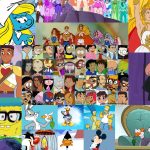The Nostalgia Factor: Cartoon characters hold a special place in our hearts, serving as companions, role models, and sources of joy during our formative years. From the colorful antics of Bugs Bunny to the heroic adventures of Superman, these characters entertained us and helped shape our childhood memories. In this analysis, we’ll explore the nostalgia factor of cartoon characters, examining how they influence our emotional connection to the past and why they continue to resonate with us long into adulthood.

The Power of Nostalgia:
Nostalgia is a powerful emotion that transports us to cherished moments from our past, evoking feelings of warmth, comfort, and familiarity. Cartoon characters play a significant role in triggering nostalgia, serving as anchors to specific periods of our childhood. Whether reminiscing about Saturday morning cartoons or cuddling up with a favorite stuffed animal while watching our favorite shows, these characters become intertwined with our memories, shaping our sense of identity and belonging.

The Role of Imagination:
Cartoon characters ignite our imaginations, transporting us to fantastical worlds filled with endless possibilities. As children, we often identified with these characters, imagining ourselves embarking on epic adventures or overcoming impossible odds. Characters like Peter Pan, who never grew up, or SpongeBob SquarePants, who lives in a pineapple under the sea, fueled our imaginations and encouraged us to embrace our creativity.

The Comfort of Familiarity:
Cartoon characters provide a sense of stability and familiarity in a world filled with uncertainty and change. Whether it’s the comforting presence of Winnie the Pooh or the zany antics of Tom and Jerry, these characters offer a sense of continuity in our lives. Revisiting our favorite cartoons allows us to escape adulthood’s stresses and reconnect with childhood’s carefree innocence, if only for a brief moment.

The Influence of Role Models:
Cartoon characters often serve as role models, imparting valuable lessons about friendship, courage, and kindness. Characters like SpongeBob SquarePants teach us the importance of optimism and resilience, while Superman instills a sense of duty and responsibility. As children, we admired these characters, emulating their virtues and striving to embody their heroic qualities. Even as adults, we continue to draw inspiration from these timeless role models, seeking guidance in adversity.

The Evolution of Animation:
As technology advances, so too does the art of animation, allowing for greater realism and visual spectacle. While modern cartoons may boast stunning CGI animation and intricate storytelling, there’s something inherently charming about the simplicity of classic hand-drawn animation. Characters like Mickey Mouse and Bugs Bunny may lack the polish of their modern counterparts, but their timeless appeal transcends the limitations of technology, captivating audiences of all ages.

The Legacy of Classic Cartoons:
Classic cartoon characters have left an indelible mark on popular culture, influencing generations of artists, writers, and filmmakers. Characters like Mickey Mouse, created by Walt Disney in 1928, paved the way for the golden age of animation and inspired countless imitators. Similarly, characters like Scooby-Doo and The Flintstones revolutionized the world of television animation, showcasing the medium’s potential for storytelling and entertainment.

The Rebirth of Nostalgia:
In recent years, nostalgia for classic cartoon characters has resurgent, fueled by reboots, remakes, and revivals. Shows like “The Powerpuff Girls” and “Teenage Mutant Ninja Turtles” have been reintroduced to a new generation of fans, while streaming services offer access to classic cartoons from decades past. This resurgence of nostalgia speaks to the enduring appeal of these iconic characters and their ability to transcend generational boundaries.

The Bond Between Generations:
Cartoon characters have a unique ability to bridge the generation gap, bringing together children, parents, and grandparents alike. Whether it’s sharing a beloved childhood favorite with a younger family member or bonding over a mutual love of classic cartoons, these characters serve as cultural touchstones that unite us across generations. In a world that often feels divided, the shared experience of watching cartoons reminds us of our common humanity and the power of storytelling to connect us all.

Conclusion:
From the whimsical adventures of Mickey Mouse to the epic battles of Superman, cartoon characters have played an integral role in shaping our childhood memories and influencing our emotional connection to the past. Through the power of nostalgia, these characters continue to resonate with us long into adulthood, reminding us of the joy, wonder, and innocence of youth. As we revisit our favorite cartoons and share them with future generations, we keep the spirit of childhood alive and celebrate the enduring legacy of these beloved characters.
Read also
- From Nostalgia to New Favorites: The 10 Best Modern Cartoon Characters
- Nostalgia Alert: Top 10 Classic Cartoon Characters from Your Childhood
- Nostalgia in Modern Cartoons: A Journey Through Time and Animation
- Navigating the Nostalgia: Exploring the Golden Age of Saturday Morning Cartoons
- Scooby-Doo and the Mystery Gang: Solving Crimes and Stealing Hearts
FAQs about The Nostalgia Factor: How Cartoon Characters Shape Our Childhood Memories
1. Q: What is the nostalgia factor about cartoon characters?
A: The nostalgia factor refers to the emotional connection and fond memories people have for cartoon characters from their childhood, which evoke nostalgia and sentimentality.
2. Q: How do cartoon characters shape our childhood memories?
A: Cartoon characters become part of our childhood experiences, influencing our imagination, playtime activities, friendships, and even our values and beliefs as we grow up.
3. Q: Why do people feel nostalgic about cartoon characters?
A: People feel nostalgic about cartoon characters because they represent a simpler time in their lives when they were carefree, imaginative, and full of wonder. Additionally, cartoons often evoke memories of bonding with family and friends over shared experiences.
4. Q: What examples of cartoon characters evoke nostalgia?
A: Examples include classic characters like Mickey Mouse, Bugs Bunny, Scooby-Doo, SpongeBob SquarePants, and Pokémon, among others, which have left a lasting impact on generations of viewers.
5. Q: How do nostalgia-driven reboots and revivals impact our perception of cartoon characters?
A: Nostalgia-driven reboots and revivals capitalize on people’s fond memories of beloved cartoon characters, often introducing updated versions of the characters and storylines to appeal to new and old fans.
6. Q: Can nostalgia for cartoon characters influence purchasing behavior?
A: Yes, nostalgia for cartoon characters can influence purchasing behavior, driving sales of merchandise, DVDs, streaming subscriptions, and tickets to theme parks or special events featuring beloved characters.
7. Q: How do cartoon characters from different eras compare regarding nostalgia?
A: Cartoon characters from different eras evoke nostalgia in different ways, reflecting the cultural, social, and technological trends of their time. However, the emotional connection to these characters remains timeless for many fans.
8. Q: Do parents often introduce their children to cartoon characters from childhood?
A: Parents often introduce their children to cartoon characters from their childhood to share something meaningful and nostalgic with them, fostering a sense of connection across generations.
9. Q: Can nostalgia for cartoon characters have therapeutic effects?
A: Yes, nostalgia for cartoon characters can have therapeutic effects by providing comfort, reducing stress, and promoting feelings of happiness and well-being, especially during challenging times.
10. Q: How do cartoon characters continue to resonate with audiences as they grow older?
A: Cartoon characters continue to resonate with audiences as they age because they represent timeless values, universal themes, and relatable experiences that transcend age, culture, and language barriers.
11. Q: Are there any psychological theories behind the nostalgia factor of cartoon characters?
A: Yes, psychologists have studied nostalgia and its effects on mental health and well-being, suggesting that reminiscing about positive childhood memories, including experiences with cartoon characters, can boost mood and self-esteem.
12. Q: What role do cartoon characters play in shaping cultural identity?
A: Cartoon characters can significantly shape cultural identity by reflecting and reinforcing societal norms, values, and traditions while challenging stereotypes and promoting diversity and inclusivity.
13. Q: How do cartoon characters influence creative expression and artistic endeavors?
A: Cartoon characters inspire creativity and artistic expression in various forms, including fan art, cosplay, fan fiction, music, and academic research and analysis, demonstrating their enduring impact on popular culture.
14. Q: Can excessive nostalgia for cartoon characters have adverse effects?
A: While nostalgia for cartoon characters is generally considered a positive experience, excessive nostalgia that interferes with daily functioning or prevents individuals from engaging with the present moment may adversely affect mental health and well-being.
15. Q: How do cartoon characters contribute to intergenerational bonding and communication?
A: Cartoon characters serve as common ground for intergenerational bonding and communication, providing shared experiences, memories, and conversation topics that bridge generational gaps and strengthen family connections.
This post was created with our nice and easy submission form. Create your post!




2 Comments